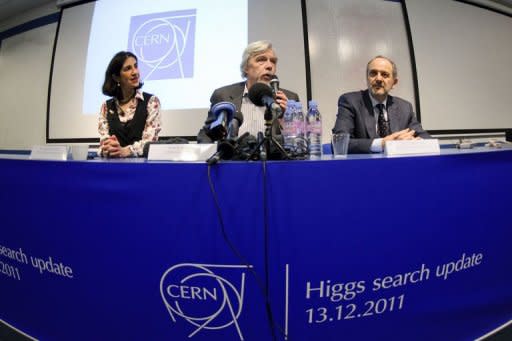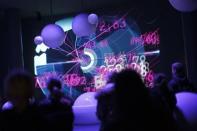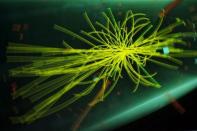Scientists narrow search for 'God particle'
Physicists said on Tuesday that they had narrowed the search for the elusive sub-atomic Higgs boson particle that would confirm the way science describes the Universe. Experiments at Europe's giant atom smasher have "reduced the window where scientists think they will find the Higgs boson," also known as the God Particle, said Bruno Mansoulie, a researcher at the European Organisation for Nuclear Research (CERN). The Higgs boson is the missing link in the so-called Standard Model of physics, which explains how the basic building blocks of observed matter fit together. Its existence -- if confirmed -- would explain in a single stroke the mystery of what gives this invisible constellation of particles mass. Such a discovery would rank in importance with major breakthroughs of the last century, going back to Einstein's first formulation of quantum physics. For now, however, the cagey boson only exists in theory. If it turns out to be a mirage, it would force scientists back to the drawing board to rewrite the textbook of particle physics. CERN reported on Tuesday the midpoint results from two separate experiments that independently arrived at the same conclusion. The Web-cast presentation was made before several hundred scientists in an atmosphere charged with excitement and punctuated with applause. Taken together, the results provide "tantalising hints" that the sought-after particle is hiding inside a narrow range of mass, CERN said in a statement. "If it exists, it is most likely to have a mass constrained to the range of 116 to 130 gigaelectronvolts (GeV)," CERN said, using the standard measure for the mass of sub-atomic particles. One GeV is roughly equivalent to the mass of a proton. Both experiments showed telltale activity at a sweet spot around 125 GeV. "It's too early to draw definitive conclusions, we need more data," said Fabiola Gianotti, head of the ATLAS group. "But we have established a solid foundation for passionately exciting months ahead," she said, adding that a definitive answer was expected within 12 months. The new results have a higher degree of certainty -- 99 percent -- but still fall well below the threshold of discovery. "For scientists, certainty requires a threshold of a no greater than five in ten million chance of error," Daniel Fournier, an Atlas researcher, told AFP. Both experiments were conducted at the Large Hadron Collider (LHC), a 27-kilometre (16.9-mile) ring-shaped tunnel straddling the French-Swiss border 100 metres (325 feet) below ground. After a shaky start, the world's biggest atom smasher has ramped up power to record levels, allowing scientists to sift through the debris of near speed-of-light collisions more quickly than expected. "We are at the beginning, but the progress has been huge. Very few people thought we would be where we are," said Guido Tonelli, leader of the second major experiment, known as CMS. Even if CERN does flush out the Higgs boson sometime next year, it will complete the picture for only that small slice of matter that is known. "Don't forget that the Standard Model only explains four percent of the Universe," Rolf Heuer, Director General of CERN, said at a press conference. "We have a long way to go." Scientists speculate that the other 96 percent of the Universe consists of dark matter (26 percent) and dark energy (70 percent), neither of which has been directly observed.











